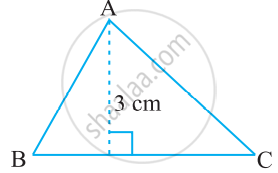Advertisements
Advertisements
प्रश्न
Find the area of ΔABC whose vertices are:
A( 3,8) , B(-4,2) and C( 5, -1)
उत्तर
A( 3,8) , B(-4,2) and C( 5, -1) are the vertices of ΔABC . Then,
`(x_1 =3, y_1=8),(x_2=-4,y_2=2) and (x_3=5,y_3=-1)`
Area of triangle ABC
`=1/2 {x_1(y_2-y_3) + x_2(y_3-y_1) +x_3(y_1-y_2)}`
`=1/2 {3(2-(-1))+(-4)(-1-8)+5(8-2)}`
`=1/2 {3(2+1)-4(-9)+5(6)}`
`=1/2 {9+36+30}`
`=1/2(75)`
=37.5 sq . units
APPEARS IN
संबंधित प्रश्न
If D, E and F are the mid-points of sides BC, CA and AB respectively of a ∆ABC, then using coordinate geometry prove that Area of ∆DEF = `\frac { 1 }{ 4 } "(Area of ∆ABC)"`
The vertices of ∆ABC = are A (4, 6), B(1, 5) and C(7, 2). A line is drawn to intersect sides AB and AC at D and E respectively such that `\frac{AD}{AB}=\frac{AE}{AC}=\frac{1}{4}` .Calculate the area of ∆ADE and compare it with the area of ∆ABC
The coordinates of A, B, C are (6, 3), (–3, 5) and (4, – 2) respectively and P is any point (x, y). Show that the ratio of the areas of triangle PBC and ABC is
If A(–5, 7), B(–4, –5), C(–1, –6) and D(4, 5) are the vertices of a quadrilateral, find the area of the quadrilateral ABCD
Find the value of y for which the points A(-3, 9), B(2,y) and C(4,-5) are collinear.
Find BC, if the area of the triangle ABC is 36 cm2 and the height AD is 3 cm.

If the sides of a triangle are 3 cm, 4 cm and 5 cm, then the area is
The area of the triangle whose vertices are A(1, 2), B(-2, 3) and C(-3, -4) is ______.
Find the missing value:
| Base | Height | Area of parallelogram |
| ______ | 8.4 cm | 48.72 cm2 |
Find the missing value:
| Base | Height | Area of Triangle |
| 22 cm | ______ | 170.5 cm2 |
